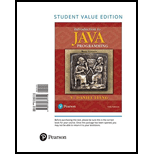
Introduction to Java Programming and Data Structures: Brief Version (11th Global Edition)
11th Edition
ISBN: 9780134671710
Author: Y. Daniel Liang
Publisher: PEARSON
expand_more
expand_more
format_list_bulleted
Concept explainers
Question
Chapter 19.3, Problem 19.3.2CP
Program Plan Intro
ArrayList:
An array list is the dynamic array data type which is used to store elements with specific type using the package “java.util.ArrayList”.
Expert Solution & Answer
Want to see the full answer?
Check out a sample textbook solution
Students have asked these similar questions
show all the work
answer question 3
Show the work
Chapter 19 Solutions
Introduction to Java Programming and Data Structures: Brief Version (11th Global Edition)
Ch. 19.2 - Are there any compile errors in (a) and (b)?Ch. 19.2 - Prob. 19.2.2CPCh. 19.2 - Prob. 19.2.3CPCh. 19.3 - Prob. 19.3.1CPCh. 19.3 - Prob. 19.3.2CPCh. 19.3 - Prob. 19.3.3CPCh. 19.3 - Prob. 19.3.4CPCh. 19.4 - Prob. 19.4.1CPCh. 19.4 - Prob. 19.4.2CPCh. 19.5 - Prob. 19.5.1CP
Ch. 19.5 - Prob. 19.5.2CPCh. 19.6 - What is a raw type? Why is a raw type unsafe? Why...Ch. 19.6 - Prob. 19.6.2CPCh. 19.7 - Prob. 19.7.1CPCh. 19.7 - Prob. 19.7.2CPCh. 19.7 - Prob. 19.7.3CPCh. 19.7 - Prob. 19.7.4CPCh. 19.8 - Prob. 19.8.1CPCh. 19.8 - Prob. 19.8.2CPCh. 19.8 - Prob. 19.8.3CPCh. 19.8 - Prob. 19.8.4CPCh. 19.8 - Prob. 19.8.5CPCh. 19.9 - Prob. 19.9.1CPCh. 19.9 - How are the add, multiple, and zero methods...Ch. 19.9 - How are the add, multiple, and zero methods...Ch. 19.9 - What would be wrong if the printResult method is...Ch. 19 - (Revising Listing 19.1) Revise the GenericStack...Ch. 19 - Prob. 19.2PECh. 19 - (Distinct elements in ArrayList) Write the...Ch. 19 - Prob. 19.4PECh. 19 - (Maximum element in an array) Implement the...Ch. 19 - (Maximum element in a two-dimensional array) Write...Ch. 19 - Prob. 19.7PECh. 19 - (Shuffle ArrayList) Write the following method...Ch. 19 - (Sort ArrayList) Write the following method that...Ch. 19 - (Largest element in an ArrayList) Write the...Ch. 19 - Prob. 19.11PE
Knowledge Booster
Learn more about
Need a deep-dive on the concept behind this application? Look no further. Learn more about this topic, computer-science and related others by exploring similar questions and additional content below.Similar questions
- Capsim Team PowerPoint Presentations - Slide Title: Key LearningsWhat were the key learnings that you discovered as a team through your Capsim simulation?arrow_forwardWrite the SQL code that permits to implement the tables: Student and Transcript. NB: Add the constraints on the attributes – keys and other.arrow_forwardDraw an ERD that will involve the entity types: Professor, Student, Department and Course. Be sure to add relationship types, key attributes, attributes and multiplicity on the ERD.arrow_forward
- Draw an ERD that represents a book in a library system. Be sure to add relationship types, key attributes, attributes and multiplicity on the ERD.arrow_forward2:21 m Ο 21% AlmaNet WE ARE HIRING Experienced Freshers Salesforce Platform Developer APPLY NOW SEND YOUR CV: Email: hr.almanet@gmail.com Contact: +91 6264643660 Visit: www.almanet.in Locations: India, USA, UK, Vietnam (Remote & Hybrid Options Available)arrow_forwardProvide a detailed explanation of the architecture on the diagramarrow_forward
- hello please explain the architecture in the diagram below. thanks youarrow_forwardComplete the JavaScript function addPixels () to calculate the sum of pixelAmount and the given element's cssProperty value, and return the new "px" value. Ex: If helloElem's width is 150px, then calling addPixels (hello Elem, "width", 50) should return 150px + 50px = "200px". SHOW EXPECTED HTML JavaScript 1 function addPixels (element, cssProperty, pixelAmount) { 2 3 /* Your solution goes here *1 4 } 5 6 const helloElem = document.querySelector("# helloMessage"); 7 const newVal = addPixels (helloElem, "width", 50); 8 helloElem.style.setProperty("width", newVal); [arrow_forwardSolve in MATLABarrow_forward
arrow_back_ios
SEE MORE QUESTIONS
arrow_forward_ios
Recommended textbooks for you
 EBK JAVA PROGRAMMINGComputer ScienceISBN:9781337671385Author:FARRELLPublisher:CENGAGE LEARNING - CONSIGNMENT
EBK JAVA PROGRAMMINGComputer ScienceISBN:9781337671385Author:FARRELLPublisher:CENGAGE LEARNING - CONSIGNMENT C++ Programming: From Problem Analysis to Program...Computer ScienceISBN:9781337102087Author:D. S. MalikPublisher:Cengage LearningProgramming Logic & Design ComprehensiveComputer ScienceISBN:9781337669405Author:FARRELLPublisher:Cengage
C++ Programming: From Problem Analysis to Program...Computer ScienceISBN:9781337102087Author:D. S. MalikPublisher:Cengage LearningProgramming Logic & Design ComprehensiveComputer ScienceISBN:9781337669405Author:FARRELLPublisher:Cengage Microsoft Visual C#Computer ScienceISBN:9781337102100Author:Joyce, Farrell.Publisher:Cengage Learning,
Microsoft Visual C#Computer ScienceISBN:9781337102100Author:Joyce, Farrell.Publisher:Cengage Learning, New Perspectives on HTML5, CSS3, and JavaScriptComputer ScienceISBN:9781305503922Author:Patrick M. CareyPublisher:Cengage Learning
New Perspectives on HTML5, CSS3, and JavaScriptComputer ScienceISBN:9781305503922Author:Patrick M. CareyPublisher:Cengage Learning Programming with Microsoft Visual Basic 2017Computer ScienceISBN:9781337102124Author:Diane ZakPublisher:Cengage Learning
Programming with Microsoft Visual Basic 2017Computer ScienceISBN:9781337102124Author:Diane ZakPublisher:Cengage Learning

EBK JAVA PROGRAMMING
Computer Science
ISBN:9781337671385
Author:FARRELL
Publisher:CENGAGE LEARNING - CONSIGNMENT

C++ Programming: From Problem Analysis to Program...
Computer Science
ISBN:9781337102087
Author:D. S. Malik
Publisher:Cengage Learning

Programming Logic & Design Comprehensive
Computer Science
ISBN:9781337669405
Author:FARRELL
Publisher:Cengage

Microsoft Visual C#
Computer Science
ISBN:9781337102100
Author:Joyce, Farrell.
Publisher:Cengage Learning,

New Perspectives on HTML5, CSS3, and JavaScript
Computer Science
ISBN:9781305503922
Author:Patrick M. Carey
Publisher:Cengage Learning

Programming with Microsoft Visual Basic 2017
Computer Science
ISBN:9781337102124
Author:Diane Zak
Publisher:Cengage Learning